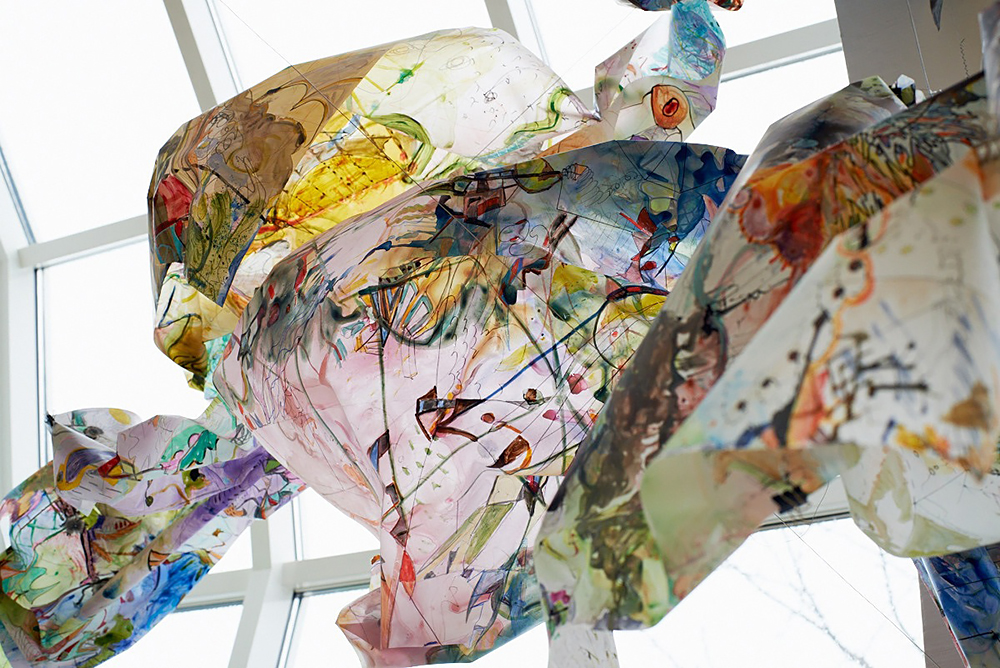“Orrustan um málverkið” (The Battle Over Painting)
exhibition review in
Morgunblaðið, Reykjavík
Review by A.Jóa. Transl. J.Proppé
17 May 2014
< back to publicity
ASI Art Museum, Reykjavík / Installation view / 2014
In her installation in the ASI-Museum, Anna Jóelsdóttir reflects on the limits of painting, on how a painting can alternately expand into the surrounding space or contract again, into its own surface. She exhibits paintings that are made with ink, colored pencils and acrylic on paper and drafting film but although drawing is a strong characteristic of Jóelsdóttir’s expression it is always flowing, colorful and painterly. The forms and figures in these works appear to grow out of the images themselves and have an air of fantasy about them.
In the piece Diary 3 April 2007 wings sprout from the surface in a narrative where beautifully colored beings appear, resembling birds or insects, perhaps even military hardware or spaceships. The painting is alive with movement and among shapes that resemble a landscape we see straight and undulating lines. It is as though the battle was being fought high above the earth and in this, Jóelsdóttir’s paintings call to mind those of Julia Mehretu that often resemble landscapes with their floating, layered chaos and fragmentation. Jóelsdóttir’s exhibition is titled “Brot”, a word that contains many shades of meaning that in English can be read as “fragment, fracture, fold and violation”. The Diary is painted on a long strip of paper in an accordion fold. The painting is thus divided into many connected parts that either reach out into the space or back inward: The narrative in a work such as Diary with 8 Chapters therefore seems linear but is nonetheless broken or cut short; it opens itself to the audience and then retreats back into the private space of the diary, pulling the curious viewer along into it fantasy-like microcosm. The viewer is then regularly thrust back out into his own space. In these diaries, Jóelsdóttir finds an interesting way to work with narrative and the limits of painting. The battles that are fought are beautiful and it is tempting to interpret then as allegories of art historical struggles where painting – abstract or figurative – is at stake.
Something similar occurs in the paintings that hang from the ceiling, snaking around like a Chinese dragon at New Year’s celebrations (there is a hint of influence from Chinese calligraphy in these paintings): It is as though the painting leads its own life, with its own thoughts and perceptions, as it feels its way, stops, retreats and then continues its journey. Strange creatures and shapes collide as symbols of the inner turmoil of the painting. In these pieces – that might well have grown from a page in one of the diaries – the artist uses drafting film which created a certain softness. She paints on both sides of the film and then cuts into it to provide for a varied and lively overall effect. One of these painted creatures seems to bend down to sniff at the audience. In one place, a black chrysalis hangs from the ceiling. There, one has to peer in through slits to see the inner reality of the painting. Perhaps this one has been wounded in the battle and is conserving its energy to help it recover.
In the pieces that have been pasted to the walls Jóelsdóttir underlines the tension between the flat surface of the painting and its three dimensional effect. In addition she shows one “traditional” painting, actually stretched on a frame. In this way she raises questions relating to painting in the Modern era and in our own time. Yet these pieces do not have the same expansive impact as the other works in the exhibition. They seem heavier and more static than the others and reduce the rhythmic effect of the overall installation – perhaps a conscious move by the artist as an expression of the disturbance caused by the “brot” or fracture. In this exhibition Anna Jóelsdóttir proves that she has not pulled back in her vigorous and creative examination of the possibilities of painting in our time.
